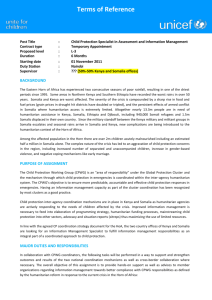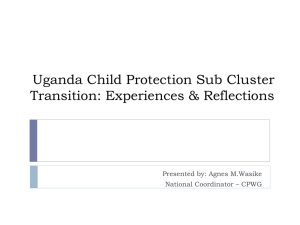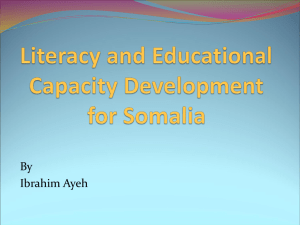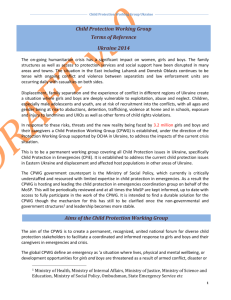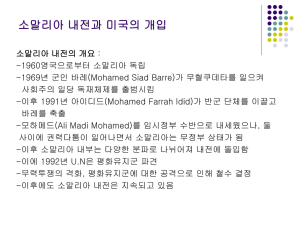CPWG-Plan-2013-2015_v2_somali
advertisement
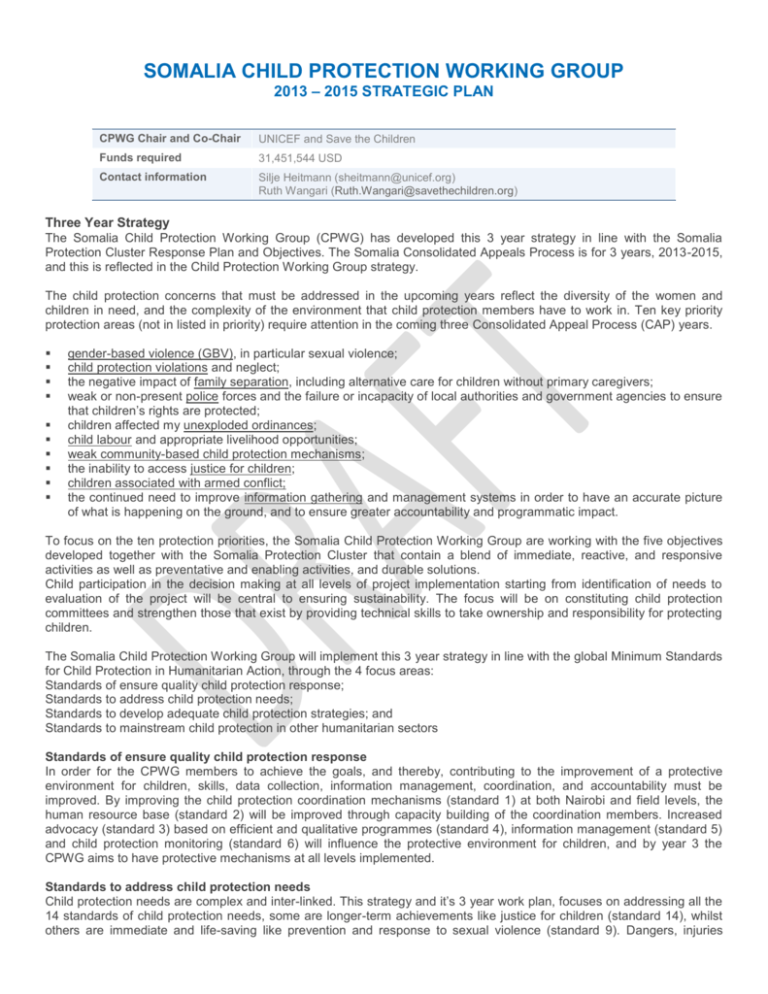
SOMALIA CHILD PROTECTION WORKING GROUP 2013 – 2015 STRATEGIC PLAN CPWG Chair and Co-Chair UNICEF and Save the Children Funds required 31,451,544 USD Contact information Silje Heitmann (sheitmann@unicef.org) Ruth Wangari (Ruth.Wangari@savethechildren.org) Three Year Strategy The Somalia Child Protection Working Group (CPWG) has developed this 3 year strategy in line with the Somalia Protection Cluster Response Plan and Objectives. The Somalia Consolidated Appeals Process is for 3 years, 2013-2015, and this is reflected in the Child Protection Working Group strategy. The child protection concerns that must be addressed in the upcoming years reflect the diversity of the women and children in need, and the complexity of the environment that child protection members have to work in. Ten key priority protection areas (not in listed in priority) require attention in the coming three Consolidated Appeal Process (CAP) years. gender-based violence (GBV), in particular sexual violence; child protection violations and neglect; the negative impact of family separation, including alternative care for children without primary caregivers; weak or non-present police forces and the failure or incapacity of local authorities and government agencies to ensure that children’s rights are protected; children affected my unexploded ordinances; child labour and appropriate livelihood opportunities; weak community-based child protection mechanisms; the inability to access justice for children; children associated with armed conflict; the continued need to improve information gathering and management systems in order to have an accurate picture of what is happening on the ground, and to ensure greater accountability and programmatic impact. To focus on the ten protection priorities, the Somalia Child Protection Working Group are working with the five objectives developed together with the Somalia Protection Cluster that contain a blend of immediate, reactive, and responsive activities as well as preventative and enabling activities, and durable solutions. Child participation in the decision making at all levels of project implementation starting from identification of needs to evaluation of the project will be central to ensuring sustainability. The focus will be on constituting child protection committees and strengthen those that exist by providing technical skills to take ownership and responsibility for protecting children. The Somalia Child Protection Working Group will implement this 3 year strategy in line with the global Minimum Standards for Child Protection in Humanitarian Action, through the 4 focus areas: Standards of ensure quality child protection response; Standards to address child protection needs; Standards to develop adequate child protection strategies; and Standards to mainstream child protection in other humanitarian sectors Standards of ensure quality child protection response In order for the CPWG members to achieve the goals, and thereby, contributing to the improvement of a protective environment for children, skills, data collection, information management, coordination, and accountability must be improved. By improving the child protection coordination mechanisms (standard 1) at both Nairobi and field levels, the human resource base (standard 2) will be improved through capacity building of the coordination members. Increased advocacy (standard 3) based on efficient and qualitative programmes (standard 4), information management (standard 5) and child protection monitoring (standard 6) will influence the protective environment for children, and by year 3 the CPWG aims to have protective mechanisms at all levels implemented. Standards to address child protection needs Child protection needs are complex and inter-linked. This strategy and it’s 3 year work plan, focuses on addressing all the 14 standards of child protection needs, some are longer-term achievements like justice for children (standard 14), whilst others are immediate and life-saving like prevention and response to sexual violence (standard 9). Dangers, injuries (standard 7), physical violence and other harmful practices (standard 8) together with sexual violence (standard 9) will be address as ongoing throughout the 3 years, while preventive planning for the same will be stepped up. Access to psychosocial support from distress and mental disorders (standard 10) will be mainstreamed throughout all child protection interventions, and while working together with the Mental Health and Psycho-Social Support Working Group on setting standards for levels of care and quality of care will be addressed during the first year. Children associated with armed groups or armed forces (standard 11) will remain a priority, as will child labour (standard 12) as the CPWG has seen increases in child labour across Somalia. Children associated with armed groups/forces and children working are often unaccompanied or separated children (standard 13), and a reunification process is under way to be mainstreamed throughout all child protection programmes during the first year. Justice for children (standard 14) remains limited as the legal system currently does not have child policies or child acts. The CPWG will advocate and work towards having child policies and child acts established in year two. In order to achieve the desired impact, assistance to child survivors of rights violations will weigh heavily towards risk reduction measures that will on the one hand allow children to restore their dignity, and on the other hand mitigate risky behaviour. Furthermore, remedies, particularly for GBV child survivors, will not be provided in isolation but as part of a package of services within the working group. Justice for children requires that children and their caregivers are able to use justice institutions to solve a common justice problem which is particularly essential to displaced, unaccompanied and separated children. Often children are unable to claim and exercise their rights to which they are entitled during displacement; and therefore, are highly vulnerable to further abuse and secondary displacement. The lack of justice for children is also an impediment to durable solutions since insecure land tenure influences the provision of humanitarian assistance and is also a significant obstacle to local integration of child-headed households. As trafficking of children continue to use Puntland as a stop-over there is a continued need to provide emergency support such as interim care, food, psycho-social and medical assistance. Concurrently, the capacity of government officials and responsible ministries in the areas of human rights, including rights of minors, must be built and strengthened. Family tracing will not only be used for purposes of reuniting trafficked children but forms a core part of reuniting families who have been separated during and after displacement. A key reason to focus on family tracing is that a whole family can better ensure its own protection than a fragmented one. Girl children are particularly vulnerable during displacements and population movements, and additional focus on ensuring girl children’s safety will be put in place. Standards to develop adequate child protection strategies Throughout Somalia the different CPWG members have raised the limited case management (standard 15) procedures for children, and the CPWG will develop a specific case management training manual during year one to be implemented across Somalia to ensure quality control and systematic interventions to protect children. Community-based child protection mechanisms (standard 16) will be strengthened throughout the country, to ensure that the communities take up their responsibilities to protect children and prevent violations. While the CPWG has developed a strategy for child friendly spaces (standard 17) the CPWG will participate in reviewing global child friendly spaces training manual during the first year and advocate towards setting up protective spaces in newly accessible areas and at cross-border points to enable the CPWG members to monitor child movements and access how best to protect excluded children (standard 18) to ensure that they do not fall outside community-based protection mechanisms. Standards to mainstream child protection in other humanitarian sectors Mainstreaming child protection to other clusters is evident in regards of ensuring a protective environment for children, and to address the different needs of children. Economic recovery (standard 19) is priority to end child labour and reduce risks of child recruitment, similarly access to education (standard 20) is key to reduce violence against children including recruitment, forced early marriages and child labour. Children’s access to health care (standard 21) is vital to prevent HIV transmission, prevent pregnancies and treat STIs for children who have been sexually violated. Nutrition (standard 22), WASH (standard 23) and shelter (standard 24) are life-saving needs for children, particularly in regards of camp management (standard 25) as we see camp structures changing in areas such as Mogadishu and Baidoa. The CPWG will during the first year ensure that these clusters have received child protection sensitization and easy practical how-to ensure child protection concerns are addressed during programming. Similarly protection concerns have been raised during distributions (standard 26), and children are neglected and violated during unsafe distributions. Children in need and target beneficiaries Category of population in need Number of Children in Need Beneficiaries targeted in CPWG’s CAP projects (endyear 2013 target) Beneficiaries targeted in CPWG’s CAP projects (end-year 2014 target) Beneficiaries targeted in CPWG’s CAP projects (endyear 2015 target) Total Children Women Men Children Women Men Children Women Men IDPs 1,447,524 715,841 215,942 124,103 715,841 215,942 124,103 715,841 215,942 124,103 Host 1,000,000 100,000 100,000 100,000 100,000 100,000 100,000 100,000 100,000 100,000 Totals 2,447,524 815,841 315,942 224,103 815,841 315,942 224,103 815,841 315,942 224,103 Explanation of number of beneficiaries targeted The Somalia Child Protection Working Group defines the population in need as being children in Somalia. Children, in one form or another, have suffered and continue to suffer from the effects of being displaced. The number of children being targeted by the Somalia Child Protection Working Group is 2,447,524, and is based on the capacity of the Working Group. CPWG OBJECTIVES AND OUTPUT TARGETS CPWG Objective I Girls and boys affected by conflict and humanitarian emergencies have equal access to timely and effective child protection responses Output: Child survivors receive equal access to timely and age and sex-appropriate response to child protection violations Mid-2013 End-2013 2014 2015 Output Indicator target target target target # of guidance notes developed 1 2 1 1 Developed Updated Updated Updated # of girl/boy survivors who receive legal counseling in line with set standards 2,000 4,000 7,000 10,000 # of girl/boy survivors who receive psychosocial assistance in line with set standards 5,000 10,000 15,000 15,000 # of girl/boy survivors who receive medical assistance, including post rape treatment within 72 hrs, in line with set standards 1,000 3,000 3,000 3,000 # of girl/boy survivors receiving material assistance in line with set standards 2,500 5,000 5,000 5,000 # of SOPs developed, revised, established Who, What, Where, When for Mental Health and Psycho-Social Support updated and gaps shared Output: Respond to the needs of separated and unaccompanied girls and boys through family tracing, reunification and reintegration with the community. Mid-2013 End-2013 2014 2015 Output Indicator target target target target # of tracing requests that have been resolved 50 150 300 500 # of boys and girls for whom a Best Interest Determination has been carried out 50 150 300 500 20% 50% 70% 100% 2014 target 2015 target 2 2 500 500 100% use of CPIMS Output: Police response to distress calls from the community in line with child protection standards Mid-2013 End-2013 Output Indicator target target # of guidance documents developed 1 1 Academy-based training curriculum revised with child protection standards 1 1 Station-based training package revised and developed with child protection standards 1 1 100 300 # of police officers trained on child protection CPWG Objective 2 To strengthen the capacity of girls and boys to reduce exposure to child protection risks Output: Girls and boys adopt safe risk mitigation strategies. Output: Protection infrastructure is improved in line with specific needs of girls and boys. Mid-2013 Output Indicator target End-2013 target 2014 target 2015 target # of child friendly UXO, IED, and mine awareness trainings conducted and awareness raising materials available 5 10 10 10 # of child friendly UXO, IED, and mine awareness raising materials available 5 10 10 10 # of guidance notes for other clusters distributed 2 5 10 Updated Output: Sustainable and safe skills training and dignified livelihoods interventions are available to vulnerable and at risk girls and boys to increase their resilience and that of their communities Mid-2013 End-2013 2014 2015 Output Indicator target target target target # of guidance notes developed 1 2 Updated Updated # of girls and boys provided with skills training for livelihood purposes 300 600 1,000 1,000 % of girls and boys people provided with skills training able to earn a minimum wage 300 600 1,000 1,000 # of community livelihood interventions targeting at youth at risk 10 20 20 20 CPWG Objective 3 To strengthen the capacity of communities, civil society, and formal and informal authorities to prevent and address the specific child protection needs of girls and boys Output: Communities and formal and informal authorities have the capacity to prevent and respond to specific child protection violations affecting girls and boys Output: Male/female duty bearers have been trained on international child protection standards. Mid-2013 End-2013 2014 2015 Output Indicators target target target target Community-based training manual finalised 1 1 Updated Updated # of campaigns conducted to inform communities on available child friendly services 5 10 20 20 # of those in positions of authority trained on gender and child sensitive approaches to child protection 20 50 100 100 # of gender and child sensitive training on child protection policies and procedures 20 50 100 100 Child Friendly Spaces training manual finalised 1 1 Updated Updated # of baseline and end-line surveys conducted 1 1 0 1 End-2013 target 2014 target 2015 target Output: Child responsive protection policies, guidelines, and legal frameworks in place. Mid-2013 Output Indicator target # of child protection policies and laws in place 1 2 3 3 # of technical support interventions provided to authorities 20 40 50 70 # of procedures in place to respond to community child protection concerns 20 50 100 100 CPWG Objective 5 To enable protection response through strengthened coordination, protection monitoring and analysis, and building the capacity of humanitarian actors. Output: Protection monitoring mechanisms in place. Output Indicator # of guidance notes and SOPs on CAAC distributed # of protection monitoring mechanisms in place # of rights violations recorded # of sex and age disaggregated reports shared Mid-2013 target End-2013 target 2014 target 2015 target 2 2 Updated Updated 2 2 2 2 300 500 500 200 6 12 12 12 Mid-2013 target End-2013 target 2014 target 2015 target 3 6 6 6 Mid-2013 target End-2013 target 2014 target 2015 target # of full-time technical / thematic coordinators 1 2 2 2 # of gender and child sensitive trainings carried out by Child Protection Working Group 6 8 12 12 # of child protection training for partners conducted 6 8 12 12 # of meetings conducted 6 12 12 12 # of monthly reports consolidated 6 12 12 12 # of assessments carried out 1 1 1 1 Output Indicator # of public advocacy interventions conducted Output: Child Protection coordination and partners strengthened. Output Indicator 2013 – 2015 Consolidated Appeals Process Projects Approved The following CPWG members have submitted and approved a CAP 2013 – 2015 project: GRT, CESVI, COSV, CRS, DF, DRC, HINNA, IIDA, INTERSOS, IOM, Save the Children, SOCPD, TASS, UNICEF, WARDA, World Vision International Attachments: Somalia Child Protection Working Group Work Plan for 2013 – 2015 Somalia Child Protection Working Group Training Matrix for 2013 Somalia Child Protection Working Group Coordination Structure (draft)
